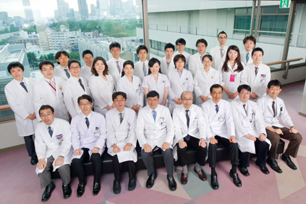Norihiro Suzuki, Professor, School of Medicine
A brain that thinks, a brain takes action -Health and Illness-
Department of Neurology—a team of internal medicine specialists at Keio who take on the challenge of uncovering the many mysteries of brain disorders

“Neurology” covers a very wide range in the field of clinical medicine. Patients with diseases that are handled by neurologists report various symptoms, not limited to such complaints as inability to move arms and legs on one side or having a hard time walking. An inability to speak clearly and difficulty swallowing are also common complaints. Even still, we treat symptoms of sensory impairment such as numbness in the arms and legs or terrible headaches; symptoms of cognitive impairment such as not being able to remember what the patient ate for breakfast or an inability to recognize family; symptoms of impaired consciousness such as when the patient doesn’t wake up when called to or loses consciousness; and even symptoms that require emergency treatment such as severe vertigo or convulsions. In neurology, we use these various symptoms to differentiate and diagnose neurological diseases such as stroke, muscular dystrophy, epilepsy, Alzheimer’s disease, Parkinson’s disease, amyotrophic lateral sclerosis (ALS), Guillain-Barre syndrome, trigeminal neuralgia, polymyositis, multiple sclerosis, mad cow disease (prion disease), myasthenia gravis, facial spasm, and migraine headache.
In addition to our around-the-clock medical activities, we also conduct vigorous research on a number of diseases in our laboratory. The main subjects of our research are uncovering the pathological conditions of dysfunction of the interactions within the cerebral blood vessel, glial cells and neurons during the acute phase of stroke, uncovering the cause of migraine headaches and their warning symptoms, developing the induced pluripotent stem (iPS) cells for neuro-degenerative disorders (such as Parkinson’s disease and ALS) and treatment using iPS cells, and identifying a new autoantibody as well as uncovering the pathological condition of myasthenia gravis. It is also our important role to passionately pass on the essence of the fast-evolving field of neurology to our medical students. Furthermore, students take independent study and lectures (basic pathognomy courses and specific studies), while receiving one-on-one guidance in clinical training (basic clinical clerkship and advanced clinical clerkship) and clinical conferences. Dreaming of the day when the results of our research lead to the complete recovery of many neurological diseases that are said to be incurable, I enjoy clinical treatment, education, and research with the young, talented individuals in the Keio University School of Medicine who make progress possible.
Student's Voice
Keisuke Yoshida, Sixth-year Student,
School of Medicine
Experiencing neurological clinical training in Japan and the U.S.
Starting from late April, I spent a month at The Johns Hopkins Hospital in the U.S. for clinical training. Johns Hopkins has been the No.1 hospital in the U.S. for 21 consecutive years and is ranked as one of the top hospitals in the field of neurology. To prepare for this overseas training, I got the opportunity to do additional clinical training in the department of neurology led by Professor Suzuki during exams and spring break. Being able to extend my knowledge on rare cases and the latest research through participating in making the rounds, attending conferences and obtaining firsthand experience of diagnostic procedures, and being able to receive explanations and questions in English helped greatly in improving my premature knowledge and poor English. Having actually gone to the U.S., I was overwhelmed by the equipment and facilities of the hospital and research facility, but felt that the medical examinations and discussions themselves were no different from Keio. Making use of my experience of clinical training in Japan and the U.S., I hope to further continue my studies in neurology.
*Position titles, etc., are those at the time of publishing.
